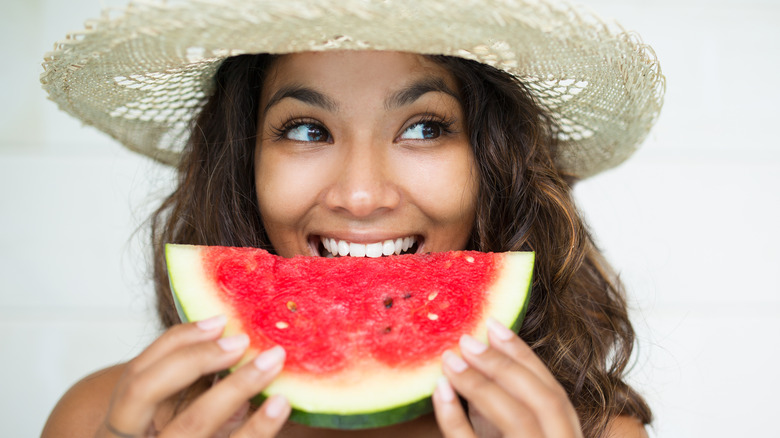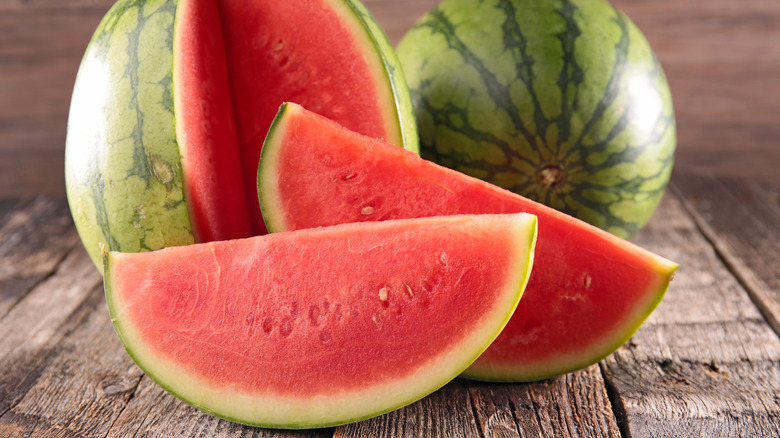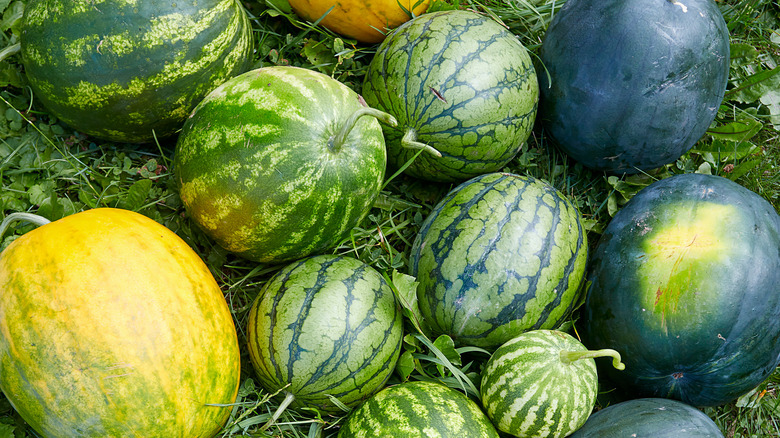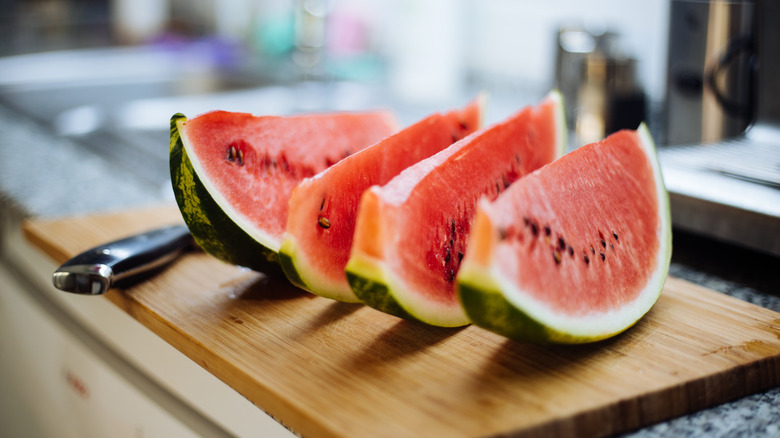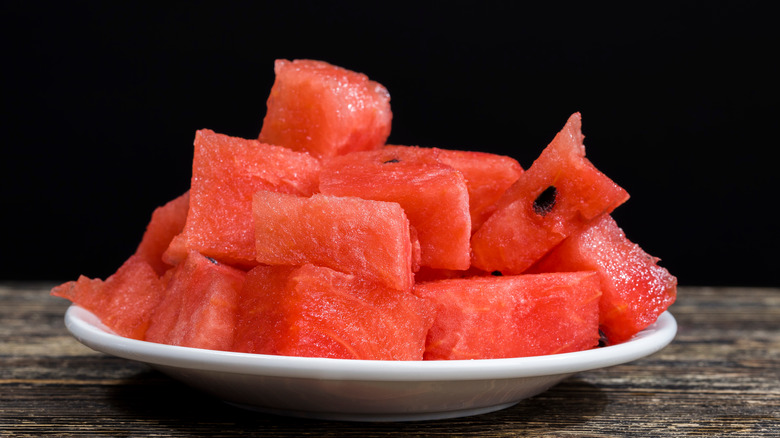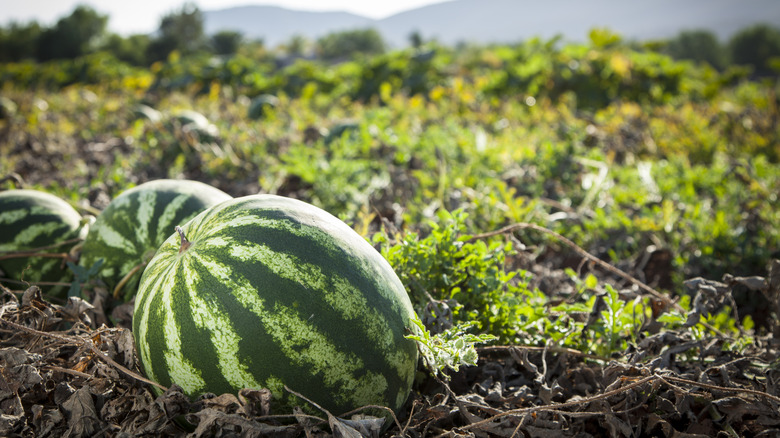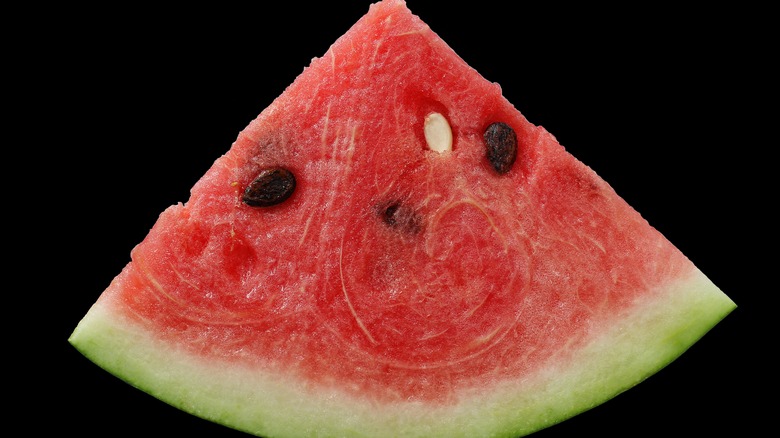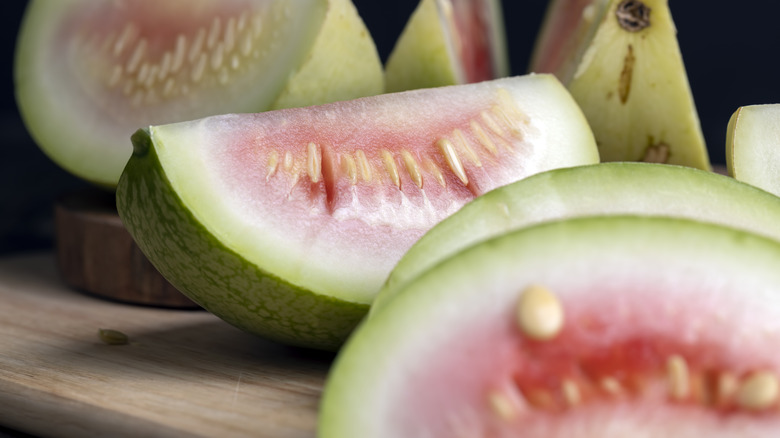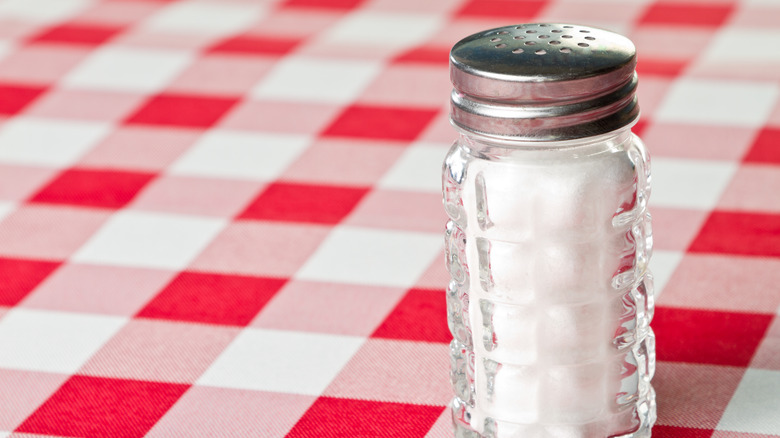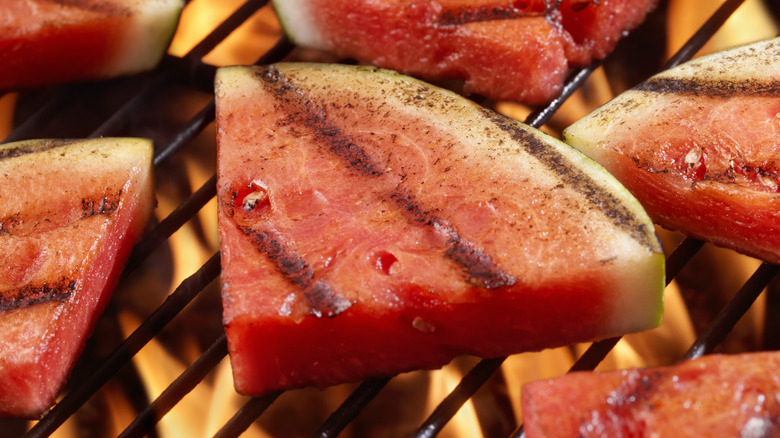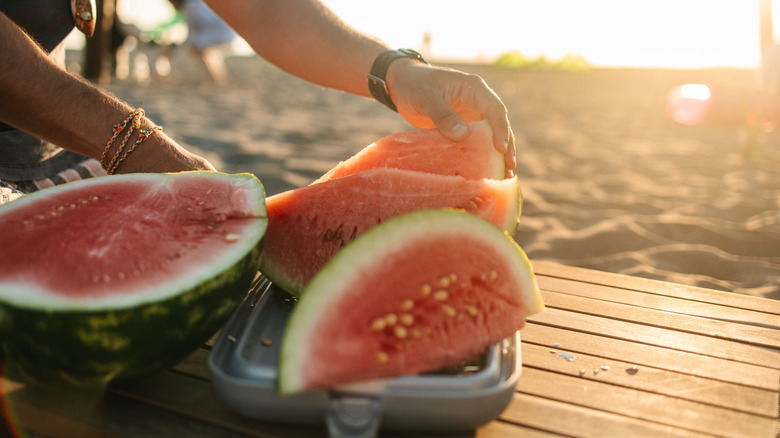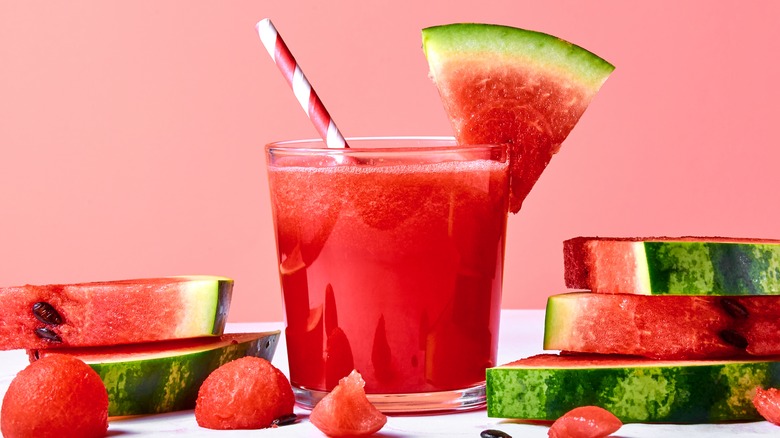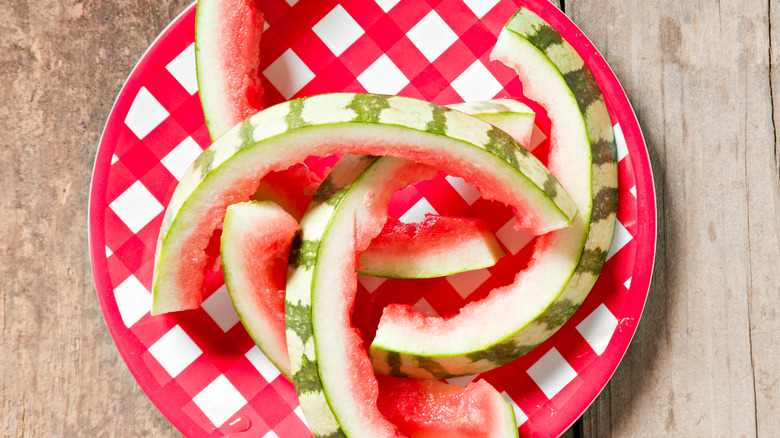All Of Your Watermelon Questions Answered
Watermelon might just be the perfect warm-weather food. It's juicy. It's sweet. And it's packed with crisp, succulent flavor. It truly is one of the most unique and delicious fruits. And you can do so many things with it, from juicing and tossing into salads, to freezing and enjoying in cocktails. But what really lurks beneath that emerald rind? Will the melon you're buying be ripe? Will it be sweet? Or will it have that weird, overripe, mealy consistency? Watermelon packs a fair amount of mystery.
If you have those thoughts as you stand in the produce aisle trying to pick out just the right melon ... you're not alone. Other popular questions people ask: Can you eat a watermelon with spots? Why are the seeds different colors? How many varieties of watermelon are there? And what do I do with all those leftover rinds? There are lots of questions regarding watermelons — and we've got the answers.
How do you make sure the watermelon you are buying is sweet?
Selecting the best tasting (whole) watermelon on sight alone can be tricky, but there are strategies that can guide your purchase. For starters, always look for watermelons that are symmetrical and uniform in shape, without irregular bumps or dents.
The melon's color should be uniformly green except for the underside, where it sat on the ground while growing. This spot should have a creamy, golden color on a perfectly ripe melon. If the spot is white or green, the melon is likely underripe. If you see brown "scars" or webs running along the underside of the melon, that's even better. These marks are called "sugar spots" and are another common indicator of ripeness and great flavor.
Moving to the melon's skin, it should be dull, not shiny — another sign of potential under-ripeness. Tap the melon and listen for a deep, hollow sound. Finally, go for heft. If you are deciding between two melons of approximately the same size and one is heavier, choose it. Heavier melons tend to have a higher water content and are also, therefore, likely packing more flavor.
How many different types of watermelon are there?
While watermelons may all appear the same in your local supermarket, there's more variety than meets the eye. According to The National Watermelon Promotion Board, a group consisting of many of the country's top watermelon farmers and growers, there are more than 300 types of watermelon grown in the United States and South America.
Varieties of melons tend to be broken down by general characteristics like shape (some are round and some are oblong), size (some watermelons come in jumbo sizes, tiny compact sizes, and everything in between), and even color. In addition to more standard watermelons with pink flesh, there are rare and unique varieties of watermelon that have yellow and orange flesh.
Beyond size and shape, watermelon varieties can also have different rind colors, patterns on their rinds, and even dramatically varied levels of sugar content within the melons themselves. Some varieties of melon are intensely sweet, almost like honey, while other heirloom varieties can taste more floral or even citrusy.
How long does a whole watermelon last before you cut into it?
Whether you're shopping for the weekend or planning on inviting a large group over and have watermelon on the menu, a whole watermelon will typically last for about seven to 10 days at room temperature. Of course, this will vary somewhat on the ripeness of the melon and how long it has been since it was harvested — older melons obviously spoil more quickly.
To prolong the life of your melon before you slice into it, make sure you store it in a cool, dry place away from direct sunlight. You should also ensure the melon is completely dry before you put it into storage — you may need to wipe it down with a dry cloth if necessary, just to be sure.
If you choose to store the watermelon in your fridge, you can extend the lifespan of the fruit by several more days. However, the colder your fridge is, the more that temperature might impact the overall flavor and texture of your melon's interior. So, if you plan on using it within a few days, it may be better to keep it at room temperature in the bottom of your pantry or in your basement.
How long does cut watermelon keep in the fridge?
Once you cut into any beautiful watermelon and can finally get a taste of its crisp, flavorful interior, you won't have that long to use up the fruit before it starts to go bad. In general, cut watermelon lasts anywhere from three to five days — and in case you're wondering, it should always be stored in the fridge.
To keep cut watermelon pieces fresh as long as possible, cover them with plastic wrap or store them in an airtight container. The more the fruit is exposed to air, the faster it will break down. You may also want to consider removing any visible seeds from the watermelon before you store it — seeds can contribute to your melon breaking down more quickly.
If you have more watermelon than you can use within a few days, consider cutting it into cubes and freezing it. Simply place the individual watermelon chunks in a single layer and let freeze until solid. Then, move them into an airtight container or bag. The frozen chunks can be used in drinks like lemonade, cocktails, or even an indulgent "booze-optional" slushie and can safely hang around your freezer for months before going bad.
When is watermelon most in season?
While watermelon might scream summer, thanks to hardworking farmers throughout North and South America, we can actually enjoy these delicious fruits year-round. The peak of watermelon season is, of course, May, June, and July, which is when the bulk of watermelon is sold in the United States. During this time, the watermelon you're eating most frequently comes from sunny, warm weather states like Florida, Texas, Arizona, California, Georgia, and even Indiana and Missouri.
Moving into the slightly cooler fall months, we continue to get watermelon from Texas, California, and the northern parts of Central America. And once winter hits, fresh watermelon takes a slightly longer trip to reach U.S. markets. These melons are typically imported from Mexico, Guatemala, the Dominican Republic, and even Brazil.
If you can't find a fresh, whole melon, The National Watermelon Promotion Board recommends looking for what they call "fresh cuts." These are the pre-cut chunks of fresh watermelon usually located in the produce section near the bagged salads, and they're typically available year-round in most areas, regardless of season.
Why are some watermelon seeds white and some black?
You've likely noticed that most seeded watermelons contain a mix of black and white seeds. But what you may not know is that only those black seeds are fully mature, adult seeds. If you plant one of them in the ground, it will grow a whole new watermelon plant. White seeds, on the other hand, are immature. They need to develop longer to actually be viable and germinate if planted.
Botanists estimate that the average watermelon can contain anywhere from 200 to 800 individual seeds, with about 90 to 95 percent of those seeds being mature (or black) at the time a ripe watermelon is harvested and the other 5 to 10 percent being immature (or white).
And if seeing all those seeds while you're enjoying your watermelon inspires you to start a garden, know that — for your seeds to actually grow — you shouldn't just toss them straight into the ground after you finish your meal. Instead, collect a handful of seeds from the melon, rinse them off, and let them air dry for several days. Then in late spring or early summer plant at least two to three seeds (in case one or more fail) about 1 inch deep in warm, slightly damp soil that gets a good amount of direct light. The seeds should sprout and start a new plant within one to two weeks. Isn't nature grand?
Can you eat watermelon seeds?
Many a grandma has warned an ornery or unsuspecting child that if they ate watermelon seeds, one of the vining plants might just take root in their belly. That's obviously not going to happen. But are watermelon seeds actually safe to eat? The answer is yes.
Both black and white watermelon seeds are edible. However, black watermelon seeds are too tough for your body to digest. They're essentially a form of insoluble fiber, which means they pass right through your system and eventually end up in the toilet. White watermelon seeds may be partially digestible and provide trace nutrients to your body, but they can also pass through your system. It simply depends on what stage of maturity each individual seed has reached.
If you're a fan of pumpkin seeds, sunflower seeds, or other edible seeds, you may also appreciate hearing that watermelon seeds can be roasted and snacked on in much the same way. Simply take as many of the seeds as you can gather from your melon when eating, toss them with a bit of oil, and roast in the oven until crispy. You can snack on them as is (once cool) or use them to add some crunch to salads, yogurt, and your favorite bowl of morning oatmeal.
Can you ripen watermelon after it has been removed from the vine?
Many types of fruit, including bananas, avocados, pears, peaches, plums, and more, continue to ripen well after they have been harvested. But sadly, watermelons — and melons of all types, in fact — are not part of that group. A watermelon will not ripen any further after it has been removed from its vine.
That's okay if you are the one growing the watermelon. You can look for other signs of ripeness before you harvest the fruit, such as the quality of the stems the watermelon is attached to. When these tendrils start to dry up and turn brown, that's another sign the watermelon is ready to pick.
However, if you're just the consumer and you end up with an under-ripe melon, you're basically stuck with what you've got. In that case, your best bet to improve the flavor of the melon is to place it in direct sunlight for a day or two before you slice it open. Although it won't ripen any further, the sun's heat may help concentrate the sugars within the melon and improve its overall taste.
If that doesn't help, cube your watermelon and serve it with other fruits like berries, grapes, bananas, and apples. When these fruits are diced up and tossed together, their sugars can help to compensate for the watermelon's lack of ripeness and bring out whatever flavors it does have.
Why do some people put salt on watermelon before eating it?
If you didn't grow up around people who salted their watermelon, seeing someone do it for the first time can be a mind-blowing experience. Why would you ever sprinkle salt all over a piece of fruit? But the reason some people enjoy salt on their watermelon is simple. It's the same reason many of us like chocolate-covered pretzels, salted caramel, bacon and maple syrup, or even a peanut butter and jelly sandwich. It's the endless appeal of salty plus sweet, a delightful pairing that makes two foods combined taste infinitely better than they ever did on their own.
Despite its naturally "salty" flavor, table salt has the power to enhance the sweetness of certain foods when it's sprinkled on them. And that's why the pairing of salt and watermelon works so well. Salt makes the flavor of watermelon even sweeter and more robust.
Salt also helps to round out the flavor of watermelon and make it more balanced. It cuts through the richness of the fruit, making it more refreshing and thirst-quenching as well — kind of like a natural sports drink.
Can you cook with watermelon?
Most fruit can be enjoyed in a variety of savory applications in addition to being eaten fresh, and watermelon is no exception. While it might seem unconventional, cooking watermelon is a great way to bring different and unique flavors out of the fruit that you might not notice or experience if you are only eating it raw.
For example, next time you're grilling, throw a few slices of watermelon over the coals next to your steaks or burgers. The flame's heat will help caramelize natural sugars in the fruit, intensifying its flavor and giving it a wonderful, smokey bite. When it's cooked, watermelon also develops a slightly firmer, meatier consistency on the outside, and this warm exterior can be a mouthwatering contrast to the fruit's cool, juicy interior. In many ways, it's similar to the appeal of a rare steak, with its savory shell and cool, juicy middle.
In addition to cooking watermelon on the grill, you can also use the fruit to make watermelon salsa. Just dice the melon and pair it with cucumber, red onion, jalapeño, cilantro, and lime juice. Or, blend watermelon with tomatoes, cucumbers, bell peppers, onions, and herbs to make a refreshing gazpacho.
For a fun twist on the classic Italian caprese salad, you can even layer slices of watermelon and manchego cheese topped with arugula pesto — we call it the Watermelon and Manchego Stack.
Can you really spike a watermelon with alcohol?
If you've ever enjoyed the beauty of a drink like a watermelon margarita or watermelon daiquiri, then you know just how well watermelon and booze go together. And while we don't know exactly which neighborhood lush first came up with the idea of spiking a watermelon, we're certainly glad they did — and that the process is so easy to replicate.
To serve a tequila, vodka, or rum-infused watermelon at your next outdoor gathering or party, begin by slicing a small portion off the side or end of a ripe watermelon to create a stable base. Next, use a sharp knife to cut a hole in the top of the melon. With that "cap" removed, use a spoon to scoop out some of the melon's flesh to create a hole. Toss in a few fresh herbs, like mint, if you'd like. Finally, add a funnel to the hole and slowly pour your alcohol of choice into the melon, letting it gradually seep in as you pour.
Let your now boozy watermelon soak for a few hours or overnight in the fridge — the longer it sits, the stronger the melon's alcohol content will become. Then, when it's time for your event, slice and serve. Be sure to enjoy in moderation since the watermelon can be surprisingly potent, and the strength of the alcohol might just sneak up on you.
Can I juice a watermelon and if so, how?
There are lots of reasons you might want a glass of pure watermelon juice. It's delicious on its own, blends brilliantly into a variety of smoothies, and is also an excellent base for a wide variety of cocktails, including watermelon sangria, watermelon-tequila Aguas Fresca, and even the decadent watermelon cosmo (a favorite of celeb chef Ina Garten). The good news is you don't need a fancy juicer or a lot of specialized equipment to make your own watermelon juice or puree. You just need a good blender or food processor.
To whip up a pitcher, you'll need at least 3 to 4 cups of fresh watermelon cubes with the seeds all removed. Place the melon in your blender and add any extra flavorings you might want, such as fresh mint, lime juice, or even a tiny drizzle of agave syrup (or any other sweetener you prefer). Finally, process until smooth.
Start with your lowest blender setting and work up in speed and power until the watermelon reaches a nice liquid consistency. You might add some water to dilute the juice if you want it to have a more mild flavor. Or, add ice cubes to make more of a frozen watermelon slush. For a smoother drink, strain the juice through a fine mesh sieve or cheesecloth to remove excess pulp — although many people prefer the juice in its purest, slightly chunky form.
Is there anything I can do with watermelon rinds?
You'll know you picked the ideal, ripe, tasty watermelon when all you're left with is a pile of leftover rinds. But don't throw those treasures away when you clean up. There's an amazing number of things that can be done with them.
Watermelon rind "pickles" are unexpectedly tasty and surprisingly easy to make. Just peel the thick green skin off your rinds and cut them into small, uniform pieces. Next, create a "brine" with equal parts water and vinegar plus sugar and salt to taste. Bring that brine to a boil and add your rind chunks, letting them simmer until tender yet still slightly crunchy. Finally, let your rind pickles cool in the fridge, and then serve.
You can also use watermelon rinds to create a rustic homemade jam. Combine 2 cups peeled, finely diced watermelon rind, 1 large peeled, diced, and cored apple, ½ cup sugar, the juice of one lemon, and ½ teaspoon of vanilla extract in a pot. Bring the mixture to a boil, lower the heat, and cook until thick, stirring frequently. Voila, instant jam. Watermelon rind can also be stir-fried, made into fritters, diced for coleslaw, and even candied or transformed into sorbet.
And if you can't bring yourself to eat it, many of the animals that might live around you will. Pigs, chickens, cows, deer, turtles, raccoons, and rabbits all enjoy nibbling on rinds that might otherwise be tossed in the trash.

